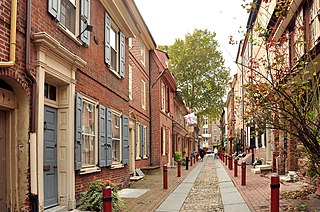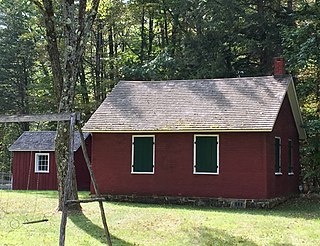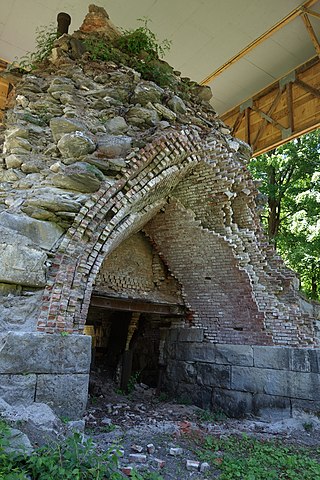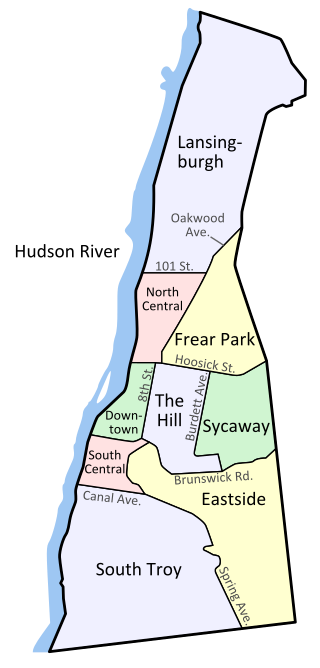Related Research Articles
The National Register of Historic Places (NRHP) is the United States federal government's official list of districts, sites, buildings, structures, and objects deemed worthy of preservation for their historical significance or "great artistic value". A property listed in the National Register, or located within a National Register Historic District, may qualify for tax incentives derived from the total value of expenses incurred in preserving the property.

The Red River Gorge is a canyon system on the Red River in east-central Kentucky. Geologically it is part of the Pottsville Escarpment.

This is intended to be a complete list of properties and districts listed on the National Register of Historic Places in Orleans County, New York. The locations of National Register properties and districts may be seen in a map by clicking on "Map of all coordinates". Two listings, the New York State Barge Canal and the Cobblestone Historic District, are further designated a National Historic Landmark.

Historic districts in the United States are designated historic districts recognizing a group of buildings, archaeological resources, or other properties as historically or architecturally significant. Buildings, structures, objects, and sites within a historic district are normally divided into two categories, contributing and non-contributing. Districts vary greatly in size and composition: a historic district could comprise an entire neighborhood with hundreds of buildings, or a smaller area with just one or a few resources.

In the law regulating historic districts in the United States, a contributing property or contributing resource is any building, object, or structure which adds to the historical integrity or architectural qualities that make the historic district significant. Government agencies, at the state, national, and local level in the United States, have differing definitions of what constitutes a contributing property but there are common characteristics. Local laws often regulate the changes that can be made to contributing structures within designated historic districts. The first local ordinances dealing with the alteration of buildings within historic districts was enacted in Charleston, South Carolina in 1931.

The U.S. National Register of Historic Places (NRHP) classifies its listings by various types of properties. Listed properties generally fall into one of five categories, though there are special considerations for other types of properties which do not fit into these five broad categories or fit into more specialized subcategories. The five general categories for NRHP properties are: building, district, object, site, and structure.

The Virginia Park Historic District is located on the north side of New Center, an area in Detroit, Michigan, along both sides of Virginia Park Street from Woodward Avenue to the John C. Lodge Freeway access road. The district was listed on the National Register of Historic Places in 1982.

There are 75 properties listed on the National Register of Historic Places in Albany, New York, United States. Six are additionally designated as National Historic Landmarks (NHLs), the most of any city in the state after New York City. Another 14 are historic districts, for which 20 of the listings are also contributing properties. Two properties, both buildings, that had been listed in the past but have since been demolished have been delisted; one building that is also no longer extant remains listed.

Brown's Race Historic District is a national historic district located at Rochester in Monroe County, New York. The district contains 15 contributing buildings, 2 contributing structures, and 14 contributing sites. All of the principal buildings are used for commercial purposes and are sited along or near the curving south rim of the Genesee River gorge at the rim of the High Falls. The district comprises a collection of 19th-century industrial buildings built of brick and stone, and ranging in size from one- to six-stories. Also in the district is the mill race and the 19th century iron Pont De Rennes bridge, which is used today as a pedestrian bridge and viewing platform of the High Falls and surrounding gorge.
The Maplewood Historic District is located in Rochester in Monroe County, New York. The district is distinguished as having landscape designs, including Maplewood Park, originally laid out by Frederick Law Olmsted.

The Poesten Kill is a 26.2-mile-long (42.2 km) creek in upstate New York located entirely in Rensselaer County, which flows westerly from its source at Dyken Pond in the town of Berlin to its mouth at the Hudson River in the city of Troy. The Poesten Creek has historically been used as a source of water for the local inhabitants and farmers. In later times it's become even more important as a source of water power during the Industrial Revolution, during which many mills and factories sprung up along its banks

Bute–Warner–Truax Farm is a historic farm complex and national historic district located at Charlotteville in Schoharie County, New York. The district includes three contributing buildings, one contributing site, and two contributing structures. It includes a Greek Revival style farmhouse built about 1853. Also included is a milk house, auto garage, fire pond, and 19th-century family burial plot.
Peter Houghtaling Farm and Lime Kiln is a national historic district located at West Coxsackie in Greene County, New York. The district contains eight contributing buildings, one contributing site, and two contributing structures. The property includes a 1794 stone house, a well and smokehouse dated to about 1794, a 19th-century privy, three 19th-century barns, an early 20th-century equipment barn and chicken coop, and 19th-century burial ground. The lime kiln is constructed of battered walls of mortared rubble limestone. It was built between 1850 and 1880.

Riders Mills Historic District is a national historic district located at Chatham in Columbia County, New York. The district includes 20 contributing buildings, eight contributing structures, and one contributing site. It includes the remnants of the one thriving hamlet of Riders Mills, located along the Kinderhook Creek and largely wiped out by a flood in 1869. Most of the buildings are residential and date to the early to mid-19th century and reflect a variety of popular architectural styles such as Georgian and Greek Revival. In addition to residences, the district includes a schoolhouse and bridge. There are also eight known archaeological sites, mostly the foundations of mills and residences.

Copake Iron Works Historic District is a national historic district located at Copake Falls in Columbia County, New York. The district includes 11 contributing buildings, three contributing sites, eight contributing structures, and three contributing objects. They are associated with the remaining vestiges of the Copake Iron Works, an iron extraction and production operation established in the mid-19th century. It includes the remains of a charcoal blast furnace, frame office and attached brick powder storage building, brick engine house and pattern shop, four frame workers houses, and a substantial Greek Revival dwelling. Also included in the district are a series of retaining walls, remnants of a cast-iron penstock, and a bridge abutment. Also located in the district is the previously listed Church of St. John in the Wilderness.

The history of Troy, New York extends back to the Mohican Indians. Troy is a city on the east bank of the Hudson River about 5 miles (8.0 km) north of Albany in the US State of New York.

Readingsburg, also known as Stone Mill, is an unincorporated community located along the South Branch Raritan River within Clinton Township in Hunterdon County, New Jersey.

The Marion Commercial Historic District is a nationally recognized historic district located in Marion, Iowa, United States. It was listed on the National Register of Historic Places in 2009. At the time of its nomination it consisted of 41 resources, which included 29 contributing buildings, one contributing site, one contributing structure, two contributing objects, and eight non-contributing buildings. The historic district covers the city's central business district. The development of this area largely occurred when Marion was the county seat of Linn County (1838-1919). There are no county government buildings extant from this era. The city was also a division point for the Chicago, Milwaukee, St. Paul and Pacific Railroad in the late nineteenth and early twentieth centuries.
The West Side Residential Historic District is a nationally recognized historic district located in Washington, Iowa, United States. It was listed on the National Register of Historic Places in 2018. At the time it was studied for the State of Iowa it contained 255 resources, which included 184 contributing buildings, one contributing site, one contributing structure, one contributing object, and 68 non-contributing buildings. Some of the numbers could be adjusted up for the National Register nomination as the park required further study. The historic district is a residential neighborhood on the west side of town with houses that were built from the 1850s to the 1960s. The oldest house in the district was constructed in 1856, and eight of the houses were built after 1969, the cut-off year for inclusion as a contributing property. All of the houses are single family dwellings, and most of them are frame construction. Nine of the houses are brick or stucco. They range in height from single-story to two-story structures. The district is noteworthy for its large collection of Victorian styles from the 1880s to the 1900s, but there are also a number of American Foursquare, American Craftsman, and bungalows in the neighborhood as well. The Joseph Keck House and the Frank Stewart House (1894) are individually listed on the National Register of Historic Places.
References
- 1 2 "National Register Information System". National Register of Historic Places . National Park Service. March 13, 2009.
- ↑ Raymond W. Smith (April 1977). "National Register of Historic Places Registration: Poesten Kill Gorge Historic District". New York State Office of Parks, Recreation and Historic Preservation . Retrieved December 6, 2010.See also: "Accompanying eight photos".

